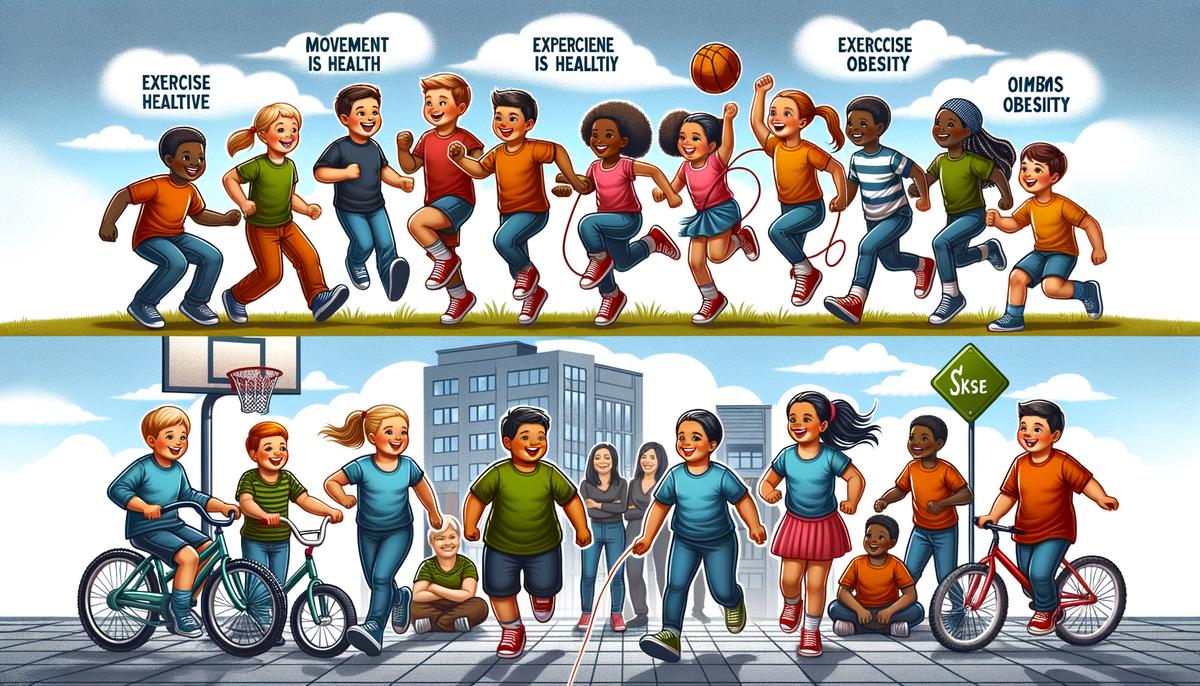Pediatric obesity is an increasingly noticeable concern on the global stage, demanding our attention for its multi-layered impact on children’s health and well-being. As we explore this subject, we consider the various elements that contribute to this growing trend, including lifestyle changes, dietary habits, and the importance of supportive environments. With each factor unpacking a different part of the puzzle, our understanding deepens, highlighting the need for a comprehensive approach in addressing pediatric obesity.
Understanding Pediatric Obesity
Pediatric obesity is a topic that’s snagging headlines and generating buzz for a very good reason. It’s becoming more common, impacting children worldwide, and it’s more than just a number on a scale. Let’s unwrap this topic together, looking at why it’s becoming a larger issue each day.
First off, children today live in a world vastly different from that of previous generations. With technology at their fingertips, there’s less encouragement or need to head outside and play. Video games, smartphones, and streaming services provide endless entertainment without requiring a single step. This shift towards a more sedentary lifestyle is one of the key factors fueling pediatric obesity.
But it’s not just about physical activity – let’s talk food. Fast food, sugary snacks, and processed meals are more accessible and appealing than ever. They’re often cheaper and faster than healthier options, making them a go-to for busy families. However, these foods are typically high in calories, sugars, and fats, contributing significantly to weight gain.
Now, consider the societal changes. Families today face more pressures than before, from economic strains to packed schedules. This hustle and bustle can lead to less time for preparing home-cooked meals or encouraging physical activities, nudging children towards easy entertainment and convenience foods.
Education on nutrition and exercise also plays a role. Not all schools have the resources to provide comprehensive health education or physical education programs. Without this knowledge, children might not understand the importance of a balanced diet and regular exercise, or how to incorporate them into their lives.
Moreover, pediatric obesity isn’t just a concern because of the higher numbers on the scale; it’s the gateway to a multitude of health issues. Children who are obese are at a higher risk for developing Type 2 diabetes, heart diseases, and even mental health issues linked to low self-esteem and bullying. These concerns stretch far beyond childhood, setting the stage for lifelong health challenges.
Recognizing the complexities and the multi-faceted nature of pediatric obesity is crucial. It’s not just about eating less or moving more; it’s about creating environments that support healthier choices, educating families and communities, and making a collective effort to reverse this growing trend.
To tackle pediatric obesity, it’s going to take a village. Families, schools, healthcare providers, and communities must work together to provide the education, resources, and support needed to foster healthier lifestyles. From simple steps like encouraging more outdoor playtime to broader initiatives aimed at improving access to healthy foods, there’s much that can be done.
Understanding the gravity and multifaceted nature of pediatric obesity is the first step towards change. With awareness, action, and a bit of creativity, we can pave the way for healthier futures for our children.

Diet Modification Techniques
Tackling pediatric obesity is a complex challenge, but making specific diet changes can play a significant role in combating this issue. It’s about more than just “eating less”; it involves making smarter, healthier food choices that can turn the tide against obesity in our youngest population. So, how does one begin to make these crucial diet changes? Let’s dive in.
Firstly, incorporating more fruits and vegetables into a child’s diet is a great starting point. These natural treasures are not only nutritious but also contain fibers that help keep the digestive system running smoothly and can lead to a feeling of fullness, which helps curb overeating. Think colorful plates with a variety of vegetables and fruits; it makes mealtime fun and appealing to kids.
Next, take a critical look at portion sizes. Today’s portions can be significantly larger than what our bodies actually need. Teaching kids to listen to their bodies and to stop eating when they’re full, rather than when their plates are clean, fosters healthy eating habits. Using smaller plates can also visually help in reducing portion sizes without feeling deprived.
Reducing the intake of sugary drinks and snacks is another vital step. Sugary drinks, including fruit juices, can be full of calories and have little nutritional value. Encouraging water or milk instead cuts down on unnecessary sugar and supports healthy growth and development. For snacks, swapping out chips and cookies for nuts, yogurt, or sliced fruits can make a big difference in daily sugar and fat intake.
Plan meals and snacks that include lean proteins and whole grains. These foods provide the necessary nutrients for growth and development while helping manage weight. Chicken, fish, beans, and legumes are great sources of protein, and choosing whole-grain bread and cereals over refined versions adds fiber, which can aid in feeling fuller for longer periods.
Cooking at home is another strategy. Fast food and ready-made meals can be convenient, but they’re often packed with unhealthy fats, sugars, and salt. By preparing meals at home, you can control what goes into your food and make healthy substitutions where needed. Involve your kids in the meal preparation process; it’s a fantastic way to teach them about nutrition and the benefits of eating well.
Lastly, remember that change doesn’t happen overnight. Start with small adjustments, and gradually build up to a healthier diet. Celebrate the victories, no matter how small, and encourage a positive attitude toward food and eating habits.
By making these diet changes, we’re not just helping our children lose weight; we’re setting them up for a healthier life. It’s about creating a foundation of good habits that can support their well-being long into the future. With patience, persistence, and a dash of creativity in preparing meals, combating pediatric obesity with diet changes can become an achievable goal. Together, let’s make a difference in our children’s health, one meal at a time.

Incorporating Physical Activity
Physical activity plays a crucial role in tackling pediatric obesity, a growing concern that endangers the health and well-being of our young ones. Just like proper nutrition, moving our bodies is essential for shedding excess weight and setting the foundation for a healthier life. Let’s dive into how incorporating exercise can make a significant difference in fighting pediatric obesity.
First up, regular physical activity helps in balancing the number of calories consumed versus the calories burned. In simpler terms, when kids move more, they use up energy that otherwise might be stored as fat. This doesn’t mean they need to run marathons or lift heavy weights. Fun activities like dancing, playing tag, or even brisk walking can do the trick, keeping them active while they have a blast.
Moreover, exercise is not just about weight loss; it strengthens the heart, muscles, and bones. By engaging in various physical activities, children can improve their cardiovascular health, increasing their overall fitness. This empowerment enables them to participate in more activities without feeling tired or out of breath, encouraging even more movement. It’s a positive cycle of health benefits!
But here’s an essential aspect: preventing obesity and managing weight is not solely about physical health. The mental boost kids get from regular exercise is phenomenal. They gain confidence as they see what their bodies can do, learn about setting and achieving goals, and relieve stress through physical exertion. This improved self-esteem and mood regulation is crucial, especially in a world where children face numerous pressures from different directions.
Creating a routine that includes daily physical activity can be a game changer. This doesn’t need to be complicated. Simple strategies like family walks, bike rides, or setting up mini-challenges at home can be incredibly effective. The goal is to make movement a regular, enjoyable part of life, not a chore.
For those wondering about the practical side of things, it’s all about finding what excites the child. Not every kid wants to play soccer or has an interest in martial arts, and that’s okay. The key is in offering options and listening to their preferences. Maybe it’s a dance class, swimming, or a junior yoga session. The variety ensures that each child can find an activity that resonates, keeping them motivated and engaged.
Lastly, teamwork makes the dream work in this battle against pediatric obesity. Encouragement from family, educators, and peers makes a monumental difference. Celebrate their effort and progress, no matter how small. A supportive environment not only boosts their current physical activity levels but also instills a lifelong love for staying active.
To wrap it up, physical activity is an indispensable ally in combating pediatric obesity. Through a thoughtful mix of fun exercises, encouragement, and a positive, supportive environment, we can steer our children towards a healthier future. Let’s get moving and make a lasting difference in their lives.

Behavioral and Psychological Support
When we talk about the battle against pediatric obesity, a crucial piece of the puzzle often gets overlooked: psychological support. You might ask, why is this so vital? Well, imagine journeying through thick and thin to improve your health but feeling alone or misunderstood along the way. Not fun, right? That’s precisely why psychological support is not just helpful but necessary.
Kids, much like adults, face an array of emotions and mental challenges that can impact their journey towards a healthier lifestyle. Fear of failure, frustration over slow progress, and even feeling singled out among peers can take a toll on their motivation. It’s like trying to climb a mountain but your backpack is filled with rocks — each one representing a mental or emotional hurdle.
What psychological support does, essentially, is help remove those rocks, one by one. A supportive environment that includes family, friends, and oftentimes, professional help, can be incredibly empowering. Professionals, such as psychologists or counselors, provide a safe space for children to express their feelings, confront their fears, and celebrate their successes. They can tailor strategies that address not just the physical aspects of obesity but the emotional ones too. Because, let’s face it, the journey to health is as much about feeling good mentally as it is about physical achievements.
Importantly, psychological support helps tackle one of the biggest challenges — maintaining motivation. We’ve all been there, right? Starting something new with all the zeal in the world only to find that enthusiasm wane over time. Kids are no different. Regular sessions with a counselor or participation in support groups can provide that much-needed motivation boost, reminding kids why they started and how far they’ve come.
But it’s not just about facing challenges; it’s also about building resilience and a positive self-image. Obesity is often accompanied by stigma and bullying, which can severely impact a child’s self-esteem. Psychological support aims to fortify a child’s mental armor, helping them understand that their worth is not tied to their weight. It’s about teaching them the skills to cope with negative comments, bounce back from setbacks, and view themselves in a positive light.
Then, there’s the aspect of developing healthy habits. Sure, we’ve talked about the importance of diet and exercise, but these habits are often impacted by our mental state. Ever found yourself reaching for a cookie when you’re stressed? That’s emotional eating, and it’s something many of us struggle with. Psychological support can help children recognize these patterns and develop healthier coping mechanisms. It’s about creating a holistic approach to health that acknowledges the importance of mental well-being.
So, when we think about fighting pediatric obesity, it’s crucial to remember that it’s not just a physical battle. The psychological aspect plays a monumental role in not just achieving but maintaining a healthy lifestyle. It’s about nurturing the mind alongside the body, ensuring that the path to better health is one paved with understanding, support, and compassion.
Remember, a healthy child is not just one who eats well and exercises, but one who is happy, motivated, and supported in every step of their journey. Their success is not just measured in pounds or inches lost but in smiles gained, confidence built, and hurdles overcome. That’s the true victory in the fight against pediatric obesity.

Policy and Community Initiatives
Understanding that our environments often dictate our health choices, policies, and community efforts play a pivotal role in shaping a healthier next generation. Cities, neighborhoods, and even local schools can be the battlegrounds for instilling lifestyle improvements among our youth. Let’s explore how strategic planning and communal endeavors can significantly influence our fight against pediatric obesity beyond diet and exercise – focusing on creating an overall healthier environment.
Envision walking through a neighborhood that prioritizes pedestrian pathways, bike lanes, and public parks. Such infrastructure encourages active transportation and outdoor play, directly combating the sedentary lifestyle witnessed with increasing technology use. By implementing these changes, local governments can foster environments where physical activity becomes part of daily life, not just an afterthought.
Local schools can serve as powerful platforms for instilling healthy habits from an early age. Imagine if every school had a garden where children could learn to grow, harvest, and prepare fresh produce. This hands-on approach not only educates them about nutrition but also embeds a deep appreciation and preference for whole foods over processed options. Furthermore, integrating more physical education classes throughout the school week ensures children receive the necessary activity to balance calorie intake and supports their overall health.
Community engagement in health initiatives also bears significant weight. For instance, weekend farmer’s markets in urban areas can improve access to affordable, fresh produce, especially in food deserts where options are scarce. Community-led fitness events, like family fun runs or yoga in the park, can make exercise both accessible and enjoyable. By rallying community support, the barrier to entry for adopting a healthier lifestyle lowers, making these pursuits less intimidating and more accepted.
In the realm of policy, enforcing regulations on advertising unhealthy food to children can drastically shift consumption habits. Children are impressionable, and limiting exposure to adverts for sugary drinks and fast food can minimize their desire for such products. Simultaneously, subsidizing healthier food options can make them more accessible to families on a budget, gradually shifting dietary habits towards more nutritious choices.
Healthy living education should extend beyond the classroom and into the community. Workshops hosted by healthcare providers on nutritious cooking, reading food labels, and managing portion sizes can empower families with the knowledge to make healthier decisions. These programs, ideally free and easily accessible, can bridge the gap between knowing what’s healthy and being able to implement it into daily life.
Finally, supporting emotional well-being is crucial. Establishing support groups within communities for children and families navigating obesity can lessen the stigma and bolster mental resilience. Creating safe spaces for sharing experiences and strategies can foster a sense of belonging and offer the emotional support needed to sustain lifestyle changes.
Through thoughtful policy-making, community engagement, and a holistic approach to well-being, we can create environments that not only support but also encourage healthier living for children. It’s a collective effort that requires creativity, compassion, and persistence but imagine the impact it could have on reversing pediatric obesity trends. Together, we can build healthier communities that pave the way for a brighter, healthier future for the next generation.

The fight against pediatric obesity is not just about shedding excess weight; it’s about laying down the foundation for a healthier, more vibrant future for our children. By taking steps to incorporate balanced diets, regular physical activity, emotional support, and fostering community initiatives, we pave the way for positive changes. Through collective effort and a dedicated focus on creating supportive environments, we can turn the tide, ensuring our children lead healthier, happier lives. The impact of these efforts promises to echo far beyond the immediate generations, setting a precedent for health and well-being for years to come.
Writio: Your automatic content writer and rank tracker. This article was written by Writio!
Thank you for reading this post, don't forget to subscribe to our free newsletter
!
